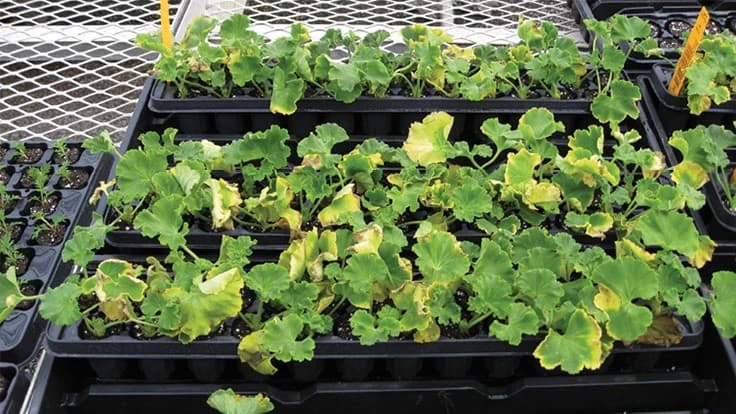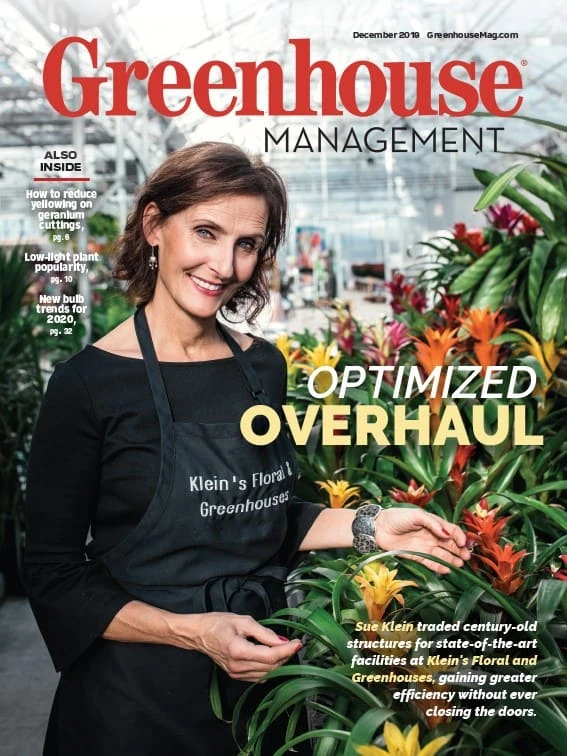

Zonal geraniums propagated by cuttings are one of the most popular annual bedding plants sold during spring. While geranium cuttings show up looking healthy and green, once they are stuck and placed in the greenhouse to root, developing yellow lower leaves on cuttings is a common problem (Fig. 1).
The problem
While geranium cuttings are in transit from Central America, a few things are happening. Or not, in some instances, which stresses cuttings. Ethylene is produced by the wounded cuttings and builds up inside plastic bags. Furthermore, carbohydrates are used up by respiring cuttings, but photosynthesis is not producing more while the plants are in dark during transit. Both factors contribute to leaves turning yellow in propagation.
Yellow leaves on geranium cuttings causes a few problems. First, the yellowing and loss of lower leaves increases disease pressure in propagation, since botrytis (Botrytis cinerea) thrives in warm, humid environments. Furthermore, unrooted cuttings rely on the carbohydrates produced from photosynthesis during rooting to maximize root growth and development. By keeping leaves healthy and on the cutting, photosynthesis is maximized during propagation, supporting new roots.
The cure
Not all geranium cultivars are as susceptible to lower-leaf yellowing as others. Research has shown that red and pink geranium cultivars are much less susceptible to lower-leaf yellowing than white, purple and salmon cultivars. However, growers cannot simply choose to not produce certain colors. The consumers want choice, and it is up to growers to meet that demand. Instead, steps should be taken to keep cuttings healthy.
The first thing to do is give geranium cuttings priority. When cuttings arrive, geraniums should be among the first cuttings to get stuck. Some cuttings are more tolerant of a small delay in sticking, but geraniums are not one of them — they should be one of the first to get stuck and placed in the greenhouse.
Once cuttings are in the greenhouse, plant growth regulators (PGRs) can suppress yellowing of lower geranium cutting leaves. Treating cuttings with a combination of benzyladenine (BA) and gibberellic acid (GA4+7) — available commercially as Fresco or Fascination — reduces lower-leaf yellowing on geraniums and can keep cuttings healthy throughout propagation. This technique may sound familiar, as the same PGRs are applied to reduce lower-leaf yellowing on Easter lilies. Neither BA or GA4+7 applied alone will solve the problem. The two active ingredients have a synergistic relationship to maintain leaf greenness for geranium cuttings.

Best management practices for applying BA+GA4+7
One of the challenges when using BA+GA4+7 on geranium cuttings is that it can slow down root development on cuttings that have been treated. The reason for this is GA has an antagonistic effect on root development, resulting in less-than-maximum root development. However, there are a few strategies to employ for minimizing any negative effects of BA+GA4+7 on roots.
First, use a rooting hormone on geranium cuttings to promote root growth and development. The root-promoting effect of auxins such as indole-butyric acid (IBA) and naphthalene acetic acid (NAA), whether alone or combined with one another, can help counteract the suppressing effect of BA+GA4+7.
Avoid getting BA+GA4+7 on the base of the cutting, where roots are formed. Some growers apply PGR solutions to the point of “runoff” or when solution is dripping off leaves. If BA+GA4+7 is applied to the point of runoff, the solution will not only drip off leaves, but will also run down the leaf petiole and down the stem to the base of the cutting. The recommended application volume for PGRs is 2 quarts of solution applied per 100 square feet. However, applying a little less than this may help avoid unwanted excess solution and help minimize negative effects on rooting.
While not all geranium cultivars are susceptible to lower-leaf yellowing, it may be challenging to pick out those sensitive cultivars among all the geraniums in a propagation house during spring. Applying BA+GA4+7 doesn’t cause any phytotoxicity, so even cultivars resistant to yellowing can be treated. This simplifies large-scale, allowing all zonal geraniums to be sprayed as part of your best management practices for rooting geranium cuttings. And when applied at the recommended concentrations, the chemical cost for sprays is less than a dollar per 1,000 square feet. Keeping your cuttings in good shape will help produce healthy and marketable flowering geraniums (Fig. 2).

Explore the December 2019 Issue
Check out more from this issue and find your next story to read.
Latest from Greenhouse Management
- Anthura acquires Bromelia assets from Corn. Bak in Netherlands
- Top 10 stories for National Poinsettia Day
- Langendoen Mechanical hosts open house to showcase new greenhouse build
- Conor Foy joins EHR's national sales team
- Pantone announces its 2026 Color of the Year
- Syngenta granted federal registration for Trefinti nematicide/fungicide in ornamental market
- A legacy of influence
- HILA 2025 video highlights: John Gaydos of Proven Winners





